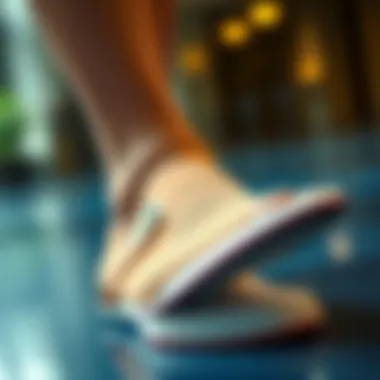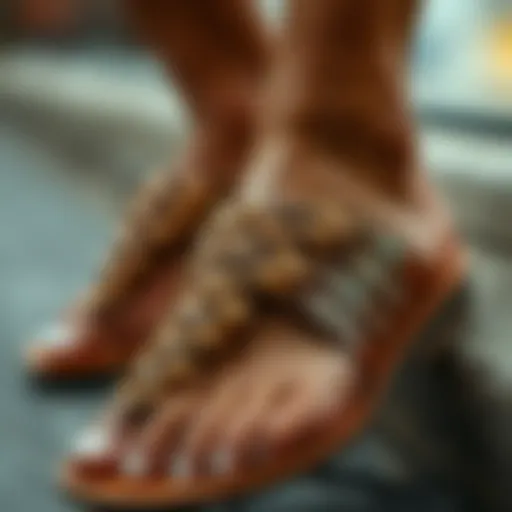Understanding Anti-Sweat Shoe Insoles for Comfort


Intro
Anti-sweat shoe insoles have become an essential topic in the footwear industry, particularly for those who prioritize both comfort and health. The rapid evolution of these insoles is not just a technological marvel, but also a response to real-world needs from active individuals and fashion-conscious consumers alike. As we step into an era where moisture control is becoming increasingly relevant in our everyday choices, exploring the intricacies of anti-sweat insoles unravels layers of functionality and style that often go unnoticed.
These insoles are designed to combat the common struggle of sweaty feet, a concern that plagues many individuals, whether they're gym enthusiasts, professionals on their feet all day, or just people wanting to make it through summer in comfort. By understanding the materials, technologies, and innovations of these insoles, consumers can make educated decisions that bolster both foot health and overall well-being.
As we delve into this topic, we’ll not only highlight the key attributes that make anti-sweat insoles a must-have but also consider their growing importance in the realms of fashion and lifestyle. This comprehensive guide aims to blend utility with design, helping you discover how these unsung heroes can enhance your wardrobe and life.
Fashion Trends
Current Styles and Influences
Fashion is in a constant state of flux, and this dynamism extends to the footwear industry as well. Today, the conversation around shoes often begins with how they can provide comfort alongside aesthetic appeal. Anti-sweat insoles fit right into this narrative.
The rise of athleisure as a dominant fashion trend has brought performance-driven footwear to the forefront. Brands such as Nike and Adidas have begun incorporating anti-sweat technology into their designs, catering to consumers who value functionality without sacrificing style. Even high-end designers are taking notice. Several luxury shoe brands have introduced limited lines featuring moisture-wicking properties, blending cutting-edge materials with chic designs.
Key Influences:
- Athleisure Surge: The growth of workout-ready clothing and shoes has pushed for more innovations in comfort technology.
- Sustainability Movement: Eco-friendly materials that also provide moisture control are becoming popular, aligning with consumer values.
- Personalization and Health: As individuals seek custom solutions, brands are responding with options tailored to foot shapes and moisture requirements.
Forecasting Future Trends
Looking ahead, the integration of smart technology in footwear is poised to change the game. Imagine insoles that not only absorb moisture but also adjust their material properties based on humidity levels throughout the day. Such advancements could revolutionize our approach to comfort in footwear.
Additionally, we might see an increase in collaborations between athletic brands and fashion designers, creating specialized lines explicitly focusing on anti-sweat capabilities. This would allow style to remain central while addressing practical needs, a necessary balance in a world that increasingly values both.
"Foot health is crucial, and with the right insoles, one can maintain not only comfort but also avoid long-term issues."
With the intersection of fashion and functionality, anti-sweat insoles are not merely an accessory anymore; they're becoming a statement of wellness and style. As we continue through this exploration, we will break down the components that make these insoles indispensable to modern footwear.
Prelude to Anti-Sweat Shoe Insoles
When it comes to footwear, comfort is king, but there's more to ensuring a pleasurable experience than just the fit and style. That’s where anti-sweat shoe insoles come into play. These unique components have become essential for those seeking to combine function with flair.
One may wonder why the focus on moisture management is vital. The main reason is simple: sweaty feet can lead to discomfort and a range of foot-related issues, becoming a source of embarrassment for many. Not only do these insoles provide a barrier against discomfort, but they also take an active role in maintaining foot health. With the right pair, you can saunter through your day without a second thought about unpleasant odors or skin irritations.
To truly appreciate the importance of these insoles, we must dive into some key benefits. First off, they can enhance overall foot breathability, which is essential regardless if you're pounding the pavement in running shoes or simply walking around town.
Beyond basic comfort, anti-sweat insoles help maintain the internal environment of your shoes. They wick away moisture effectively, creating a much more hospitable environment for your feet, while reducing the likelihood of fungal infections and other skin issues.
In addition, the choice of materials plays a critical part. Various options lend different properties to insoles, influencing their effectiveness in moisture control.
Now, let’s turn to the nitty-gritty and gain a better understanding about how moisture management works in these insoles.
Understanding Moisture Management
Imagine you're out for a hike, navigating rocky paths or winding trails under the sun. Your feet start to sweat, and before long, you start feeling that all-too-familiar dampness within your shoes. This is where moisture management enters the game. Anti-sweat insoles are designed to combat this very scenario. They often incorporate moisture-wicking technologies that pull sweat away from your feet and transfer it to the outer layers of the material.
For instance, materials like polyester and foam, specifically engineered for breathability, function effectively in this role. They’re not just your run-of-the-mill fabrics; they are meticulously chosen to ensure that moisture is distributed evenly and dries quickly. This prevents soggy socks and slippery sensations that nobody finds pleasant.
Importance of Breathability in Footwear
Breathability shouldn’t be an afterthought. In fact, it’s a pivotal aspect of a good footwear experience. Good ventilation in insoles allows air to circulate, maintaining a comfortable microclimate inside the shoe.
When shoes lack breathability, the environment can feel stifling. This can lead to sweat accumulation, resulting in a breeding ground for bacteria and fungi. Not only does that heighten the risk of odors, but it also opens the door to unwanted skin infections.
Additionally, a breathable insole can bolster your performance during various activities, such as running or casual outings. Who would want distractions like hot, sweaty feet when they’re trying to enjoy a jog or navigate a crowded market? With good moisture management and breathability, you can remain focused on your surroundings, rather than being sidetracked by foot discomfort.
In summary, the exploration of anti-sweat shoe insoles can't be overstated. These insoles are an intersection of comfort, health, and innovation, representing the evolving needs of today’s lifestyle. As we continue this article, we will delve deeper into the diverse materials involved and their impact on the performance of anti-sweat insoles.
Types of Insoles and Their Materials
When it comes to anti-sweat shoe insoles, understanding the types and materials used is crucial. The essence of these insoles goes beyond merely keeping our feet dry; it’s about enhancing comfort, preventing discomfort, and even ensuring our footwear stays fresh. Various types of materials are employed in crafting these insoles, each bringing its own set of benefits and considerations to the table.
Synthetic Materials in Anti-Sweat Insoles
Synthetic materials play a pivotal role in the construction of many anti-sweat insoles. One key advantage of synthetics is their moisture-wicking ability. For instance, insoles made with polyester or other engineered fibers can effectively draw sweat away from the skin and evaporate it quickly. Think of it as building a miniature moisture-management system right in your shoes.
Moreover, these materials often offer durability and resilience; they can withstand daily wear and tear without losing their integrity. Brands like Dr. Scholl’s and Spenco have invested in creating synthetics that not only help manage sweat but also provide arch support, making them suitable for long hours of use.


It’s important to note, however, that synthetic materials might not be as breathable as natural options. This can lead to a warmer environment for your feet on hot days, which is something to consider depending on your climate and footwear choices.
Natural Fiber Options
On the other end of the spectrum, natural fiber insoles provide an alternative that many find appealing for various reasons. These materials, such as wool or cotton, offer a breathable structure that enhances airflow to the foot. This natural breathability helps keep feet cooler during activities, making it a popular choice among those who prefer eco-friendly products.
Natural fibers also possess innate moisture-absorbing qualities. Wool, for instance, can absorb a considerable amount of moisture before it feels wet. This means they not only help control sweat but can also better handle humidity.
One downside, however, is that natural fibers might not offer the same level of durability compared to synthetic alternatives. They may wear out faster in high-performance scenarios, requiring more frequent replacements. Nonetheless, brands like Birkenstock have expertly combined natural fibers with innovative designs to ensure comfort without compromising on wearability.
Innovative Technologies in Insoles
The landscape of anti-sweat insoles has advanced greatly with the integration of innovative technologies. Features such as antimicrobial treatments and advanced cushioning systems have become game-changers. For instance, technologies like Odor-Eaters™ work to combat foot odor by targeting odor-causing bacteria at their source. This is a particularly valuable feature for athletes or individuals on their feet all day.
Cushioning technology has also evolved. Companies like Nike have developed insoles with responsive cushioning that adapts to the wearer’s foot movements while managing moisture. This can make a significant difference in comfort and performance, especially during high-intensity activities.
"Innovation in materials isn't just about comfort; it's about crafting insoles that adapt and respond to our daily demands."
Investing in anti-sweat insoles that incorporate such advancements not only makes them a smarter choice but also ensures that your footwear keeps up with your lifestyle.
In summary, navigating through the types of materials available in anti-sweat insoles is an essential step toward making informed footwear choices. Whether you lean towards durable synthetics, breathable natural fibers, or cutting-edge technology, being aware of these various attributes will empower you to select insoles that meet your unique needs. The right choice can significantly enhance overall foot health and comfort.
Mechanisms Behind Anti-Sweat Properties
When it comes to footwear, understanding the mechanisms that keep feet dry and comfortable is fundamental. Anti-sweat shoe insoles play a pivotal role in moisture regulation, ensuring that wearers can go about their day without discomfort or distraction. The science behind these insoles is multifaceted, encompassing technologies that not only wick away sweat but also combat odors that arise from prolonged wear.
Moisture-Wicking Technology
Moisture-wicking technology is the hero of anti-sweat insoles. This feature is designed to draw moisture away from the foot and facilitate evaporation. Unlike traditional materials, which tend to absorb moisture, moisture-wicking fabrics push sweat to the surface, where it can evaporate more quickly. This process minimizes the dampness that leads to foot discomfort.
While various fabrics can possess moisture-wicking properties, the efficacy of the insoles often comes down to the specific materials used. For instance, proprietary synthetic blends are increasingly popular due to their lightweight properties and durability. Moreover, certain brands, like Sof Sole, have developed insoles that utilize specialized polymers for superior moisture management.
A crucial element to consider is the breathability of the insole. Breathability allows airflow while keeping moisture in check. This characteristic maintains a cooler environment for the feet. Insoles engineered with perforations or mesh panels, like those you might find in Dr. Scholl's products, often enhance air circulation, providing an additional layer of comfort.
"Moisture-wicking technology, when paired with breathable materials, drastically reduces the chances of developing blisters or fungal infections."
Odor Control Mechanisms
Another consideration in the realm of anti-sweat shoe insoles is the inevitable issue of odor. Prolonged exposure to moisture can lead to unpleasant smells and even skin irritations. Hence, odor control mechanisms are essential features in these insoles. They often incorporate antimicrobial agents to prevent the growth of bacteria, which are the primary culprits behind foul foot odors.
Common materials used for odor control include activated charcoal and silver nanoparticles. Activated charcoal, for instance, has a porous structure that both absorbs moisture and neutralizes odors. On the other hand, silver nanoparticles work at a microscopic level, hindering the development of bacteria and fungi.
When selecting insoles, it's important to check product descriptions for such technologies. Brands like Powerstep often highlight these features in their marketing. A well-designed insole doesn't just keep feet dry; it also ensures a fresher and healthier foot environment.
To learn more about effective moisture management, visit Wikipedia. \ For tips regarding foot care and odor management, check out content on health-focused sites.
Health Benefits of Anti-Sweat Insoles
The selection of appropriate insoles can significantly influence foot health and comfort, especially when it comes to anti-sweat designs. Anti-sweat insoles are engineered to manage moisture effectively, contributing to overall foot hygiene and well-being. Given the extensive time many people spend on their feet daily, the importance of these specialized insoles cannot be overstated. They not only provide comfort but also play a crucial role in preventing a range of health issues associated with excessive moisture and foot odor.
Reducing Foot Odor and Discomfort
When the temperature rises or we engage in prolonged physical activities, our feet often become a breeding ground for bacteria and fungi. This can lead to foul odors and uncomfortable sensations that turn an enjoyable day into a struggle. Anti-sweat insoles tackle this issue directly by utilizing moisture-wicking technology, which helps absorb sweat and encourages airflow within the shoe.
- Enhanced comfort: The primary objective of these insoles is to keep feet feeling dry and comfortable, which can improve concentration and performance in sports or daily activities.
- Odor management: Certain anti-sweat insoles contain antimicrobial properties designed to neutralize odor-causing bacteria. This means that not only do your feet feel fresher, but they also will look more appealing, regardless of how long they’ve been in shoes.
- Material matters: Many users don’t realize that the choice of materials in insoles greatly affects their performance. For instance, insoles made from synthetic fibers often outperform their natural counterparts in terms of moisture control and odor prevention.
"Feet are often overlooked, yet they are the foundation of our mobility. True comfort and health start from the ground up."
By integrating anti-sweat insoles into footwear, individuals help ensure that their feet remain not only dry but also comfortable, thereby reducing the risk of discomfort and social anxiety related to foot odor during close interactions.
Prevention of Skin Conditions
Foot health is not merely a cosmetic concern; it is vital to overall health. Excessive moisture can lead to skin conditions such as athlete’s foot or fungal infections, commonly caused by the combination of heat and sweat trapped in shoes. Here’s how anti-sweat insoles contribute tremendously to the prevention of these issues:
- Moisture management: By efficiently pulling sweat away from the foot and into the material where it can evaporate, these insoles drastically lower the chances of developing skin irritations.
- Supportive features: Some insoles come equipped with enhanced arch and heel support, reducing overall foot strain and consequently minimizing the likelihood of skin disturbances.
- Regular maintenance: It's also worth mentioning the importance of regularly cleaning or replacing anti-sweat insoles to maintain their efficacy. Just like any other aspect of footwear, they work best when cared for adequately.
Choosing effective anti-sweat insoles can result in healthier feet, potentially staving off issues that could arise from prolonged moisture exposure. People often underestimate how much of an impact a good insole can have not only on their comfort but also on their skin's health.
In sum, anti-sweat insoles confer a range of health benefits that speak to the need for informed choices in footwear. They go beyond mere comfort by directly influencing foot hygiene and contributing to long-term health. Making strides towards better foot health is as simple as selecting the right insole.
Choosing the Right Anti-Sweat Insoles


Selecting the appropriate anti-sweat insoles is a crucial step toward achieving not just comfort in footwear but also maintaining foot health. With a sea of options available, understanding what works best for your personal needs can make a notable difference. Poor choices can lead to discomfort, increased sweat, and even foot-related issues over time. Here, we delve into essential considerations that can guide your selection process, ensuring a tailored fit for both your lifestyle and foot type.
Assessing Individual Foot Needs
Each foot is unique, and what suits one person may not suit another. Understanding the specific anatomy of your feet is paramount before diving into the world of insoles. Here are a few aspects to consider:
- Arch Type: Flat feet, neutral arches, and high arches all require different types of support. A high arch typically benefits from softer insoles with cushioning, while flatter feet may require firmer support to prevent overpronation.
- Foot Shape: Do you have wider or narrower feet? It’s essential to find insoles that accommodate your foot shape without cramping your style. Many brands offer options for different widths.
- Activity Level: Consider how often you wear your shoes. If you’re on your feet all day, a denser foam for added stability may be beneficial. For athletes, look for insoles geared towards moisture management and shock absorption.
With these considerations, it's essential to try various insoles. As the adage goes, "try before you buy." Getting a feel for how different materials and fits respond to your foot can save you from unnecessary headaches down the road.
Evaluating Insole Thickness and Cushioning
Once you’ve ascertained your foot needs, the next step involves evaluating the thickness and cushioning of potential insoles.
- Thickness: Thicker insoles often provide more cushioning but might alter the fit of shoes that are already snug. If you pick an insole that’s too thick, it could make your shoes feel tight and uncomfortable. Additionally, the fit of your footwear can significantly affect whether you experience discomfort or support.
- Cushioning Material: Various materials offer different levels of cushioning — gel inserts provide a soft landing for your feet, while polyurethane foam tends to be more supportive and durable. It’s essential to think about what materials feel best against your foot and how well they can handle moisture if you're tackling sweaty conditions.
- Purpose Specificity: Some insoles are designed specifically for certain activities, such as running or standing for long hours. For runners, look for insoles with additional arch support and shock-absorbing features that might prevent strain and injury.
Ultimately, determination on thickness and cushioning will vary largely based on personal preference and individual needs.
In summary: Choose insoles that not only feel good but also meet the demands of your daily activities. Do not hesitate to experiment and gradually narrow down what supports you most comfortably.
For more insights into foot health and insole technology, visit resources like NHS or check dedicated forums on platforms like Reddit.
By taking these factors into account, you can effectively navigate the market with confidence, ensuring that your selection enhances your overall experience in footwear.
Application in Various Sports and Activities
The application of anti-sweat shoe insoles spans a wide array of sports and casual activities, each with its own unique demands on footgear. Understanding these applications is essential, not only for amateur enthusiasts but also for professionals in the field looking to optimize performance and comfort. Suitable insoles can be the difference maker between a successful activity and an uncomfortable experience. Consequently, proper choices can lead to better performance, increased comfort, and importantly, enhanced foot health.
Running and Athletic Shoes
When it comes to running, choosing the right anti-sweat insole can feel like finding a needle in a haystack. Runners often face challenges like overheating feet, excessive moisture, and subsequent odor. This isn’t just uncomfortable; it may lead to more serious issues such as fungal infections or blistering. That said, selecting insoles with excellent moisture-wicking properties becomes crucial.
Here are several essential elements to consider:
- Moisture Control: Look for materials that effectively wick away sweat, promoting a dryer environment and preventing the development of odor.
- Cushioning: A well-cushioned insole alleviates impact, which can be invaluable when pounding the pavement. Gel-based options are popular for their shock-absorbing qualities.
- Breathability: Adequate airflow helps keep your feet cool during intense runs, minimizing sweat buildup. Open-cell foam is a great example of a breathable material.
Incorporating these elements into running shoes not only enhances comfort but also reduces shifting within the shoe, allowing for a more stable stance while increasing performance.
Casual and Lifestyle Footwear
The influence of anti-sweat insoles extends into the realm of casual and lifestyle footwear, where comfort is equally paramount. For everyday wear, whether you are strolling through the city or standing for extended periods, these insoles play a significant part in ensuring that your feet remain as fresh as a daisy.
Key factors to consider in this context include:
- Fashion Compatibility: Many consumers are architecture-aware, meaning they want fashionable shoes that also perform well. Insoles boasting sleek designs and colors can do just that.
- Versatility: A versatile insole that fits multiple types of shoes from sneakers to casual loafers is a wise investment.
- Long-lasting Odor Control: Many lifestyle insoles come equipped with treatments designed to combat odor and promote longevity, ensuring that your footwear remains pleasant even after all-day wear.
In both running and casual settings, the focus is remarkably similar; the goal is comfort without compromising style. > Choosing the right anti-sweat insole ultimately enhances both daily living and active pursuits. Paying attention to the specific needs of your footwear type will ensure that you not only look good but feel good too.
In sum, whether sprinting towards fitness goals or navigating the hustle and bustle of daily life, the right insoles are key to foot health and overall comfort. A thoughtfully chosen insole can elevate shoes from mere belongings to a crucial part of a stylish lifestyle.
Environmental Considerations and Sustainability
In today’s world, the conversation around sustainability has grown increasingly relevant. As consumers become more aware of the environmental implications of their purchases, brands and manufacturers are adapting accordingly. The realm of shoe insoles is no exception. Anti-sweat shoe insoles, while providing comfort and hygiene, also face scrutiny regarding their environmental footprint. This section will explore the importance of eco-friendliness and sustainable practices in the development of these insoles.
Eco-Friendly Materials for Insoles
Choosing the right materials for anti-sweat insoles is a critical step in decreasing environmental impact. Many traditional materials contribute to long-term waste and pollution. Here are some eco-friendly materials that are gaining ground in this field:
- Cork: Naturally harvested, cork is biodegradable and renewable. It’s also effective at moisture absorption, making it an ideal candidate for insoles.
- Recycled Rubber: This material helps reduce landfill waste and is durable, providing solid support and moisture control when used in insoles.
- Organic Cotton: Unlike conventional cotton, organic cotton is grown without harmful pesticides and chemicals. This not only benefits the environment but also provides a soft touch against the skin.
- Hemp: Hemp is a resilient plant that requires significantly less water and no harmful fertilizers. Its fibers are naturally moisture-wicking, enhancing the performance of insoles.
- Biodegradable Foam: Some companies are developing foams that break down more rapidly in landfills than traditional materials, thereby reducing their footprint.
Opting for these materials represents a small yet significant step toward implementing more sustainable practices in footwear. Brands that prioritize these materials cater to an audience increasingly keen on making responsible choices.
The Impact of Insoles on the Environment
While the primary function of insoles might be to enhance foot comfort, their production and disposal have broad environmental implications. Here’s a closer look at how these factors play a role:
- Manufacturing Processes: The methods employed to create traditional insoles often involve toxic chemicals and processes that emit hazardous waste. Brands focusing on eco-friendly alternatives typically utilize less harmful techniques, contributing to a cleaner manufacturing process.
- Longevity and Waste: Insoles that are built to last reduce the frequency of replacements. This, in turn, lowers overall waste. Using durable, natural materials also ensures a smaller volume of product discarded over time.
- Recyclability: Not all insoles can be easily recycled once they have reached the end of their life cycle. Manufacturers that consider the recyclability of their products contribute to a more circular economy. Some companies offer take-back programs, allowing consumers to return used insoles for recycling.
- Carbon Footprint: The production and transportation of insoles contribute to carbon emissions. Sourcing materials locally can help minimize this impact. Awareness around where these materials come from is essential for consumers looking to reduce their carbon footprint.
"The journey toward sustainability in footwear did not start yesterday, and it certainly won't end tomorrow. It's a marathon, not a sprint."


In summary, the environmental considerations in the production of anti-sweat insoles encompass various factors, from materials to manufacturing practices. As awareness grows among consumers and businesses, improved practices can help forge a path towards a more sustainable future for footwear.
Customization and Personalization of Insoles
When it comes to comfort and performance, one size rarely fits all. The customization and personalization of insoles has gained traction as an essential aspect of footwear design. For those who spend long hours on their feet, the difference between generic insoles and personalized ones can be monumental. Personalization caters to the unique contours of an individual’s feet, providing not just comfort but also support tailored specifically to their needs.
Moreover, a customized insole system can help in addressing specific concerns like arch support, heel pain, or even issues stemming from improper alignment. The wealth of options available for customization ensures that each person's unique foot structure and gait can find a supportive counterpart.
Custom Fit Options
Custom fit options are pivotal in achieving maximum comfort. Many brands now offer insoles that can be molded to the shape of the user’s foot. For instance, brands like Superfeet and Dr. Scholl's provide insoles that you can heat and then mold for a snug fit.
Considerations for Custom Fit:
- Foot Size and Shape: Measuring both length and width is crucial for finding a good fit. People often forget that feet can change shapes over time.
- Arch Type: High arch, flat foot, or neutral arch? Understanding your arch type can significantly influence your choice of insole.
- Activity Level: Different activities place varying demands on the foot. A runner might need more cushioning compared to someone who primarily walks.
Add-Ons for Enhanced Comfort
There's more to comfort than just the fit. Add-ons for enhanced comfort can elevate the insole experience. Many insoles come equipped with extra features or can be augmented for a better outcome.
- Gel Cushioning: Provides shock absorption, making it ideal for high-impact activities like running.
- Moisture-Wicking Layers: Often the first line of defense against sweat and odor. These layers help manage perspiration and keep the feet dry, especially during extensive activities.
- Arch Supports: Removable arch support options enable you to customize for additional support according to your preference.
"The right insole isn’t just an accessory; it’s foundational to foot health and overall well-being."
In sum, whether you’re looking for support while hiking or wish to mitigate discomfort during an office workday, investing in the customization and personalization of insoles pays dividends in both health and overall comfort. It empowers the wearer to fully engage in their daily routines, without the constant reminder of foot fatigue or discomfort.
Future Trends in Anti-Sweat Insole Technology
In our fast-evolving world, the shoes we wear are not merely fashion statements but significant contributors to our health and comfort. As technology strides ahead, the future of anti-sweat insoles holds unparalleled promise, merging function with innovation. This section unfolds the pivotal advancements that are shaping the landscape of insole technology, with a spotlight on the integration of smart features and the latest breakthroughs in moisture control.
Smart Insoles and Wearable Technology
When it comes to the intersection of footwear and technology, the trend of smart insoles stands to redefine our understanding of comfort and performance. These insoles are embedded with advanced sensors designed to monitor various aspects of foot health and activity. By collecting data in real-time, they offer insights that can significantly enhance athletic performance and everyday comfort.
- Biometric Monitoring: They can track metrics such as pressure points, stride patterns, and even temperature fluctuations within the shoe, helping individuals address potential issues before they become significant problems.
- Mobile Integration: Many smart insoles sync seamlessly with smartphone apps, providing users with personalized feedback and guidance. It's not uncommon for athletic enthusiasts to access tailored training regimens based on the data gathered from these insoles.
- Health Insights: Beyond performance, they can help identify health concerns like poor circulation or unusual wear patterns, enabling users to make informed decisions regarding their footwear choices and overall foot health.
In this era of wearables, smart insoles present an incredible opportunity for individuals eager to optimize their foot health while on the move. It's about time our footwear gets smarter, don’t you think?
Advancements in Moisture Control
The next frontier in anti-sweat insoles is all about elevating moisture control capabilities. Recent advancements focus on two main elements: the enhancement of moisture-wicking technologies and the introduction of sustainable materials that promise effective moisture management without compromising comfort.
- Enhanced Moisture-Wicking: Leading brands are continuing to innovate with materials that absorb and evaporate sweat more efficiently. New fabric blends are being engineered to facilitate not just superior moisture management but also quick drying times.
- Antimicrobial Innovations: The introduction of antimicrobial treatments in materials is becoming standard practice. These treatments actively combat odor-causing bacteria, thus prolonging the freshness of the insoles.
- Natural and Eco-friendly Materials: In response to heightened awareness of environmental issues, many manufacturers are shifting towards natural fibers and biodegradable materials. This evolution not only caters to moisture management but also aligns with the growing consumer demand for sustainable products.
"A shoe is not only a fashion statement; it encapsulates our daily comfort and well-being. The future is in insoles that think for us, alleviating discomfort and keeping our feet fresh."
The advancements in moisture control denote a significant shift in the expectations of consumers. As the balance between sustainability and performance improves, we stand to benefit tremendously in our quest for healthier, more comfortable footwear options.
In summary, the future trends of anti-sweat insole technology mark exciting territories that blend health, sustainability, and technology—a trifecta poised to enhance not only our daily comfort but also our overall foot health as we stride into the future.
Ending: The Role of Anti-Sweat Insoles in Modern Footwear
In an increasingly health-conscious society, the importance of foot comfort and hygiene has surged. Anti-sweat insoles serve not just as a utility but as a bridge between comfort and overall well-being. These insoles uniquely address the challenges posed by moisture in footwear, offering solutions that enhance both style and health.
The benefits of integrating anti-sweat insoles into daily footwear choices are manifold. Firstly, they contribute significantly to foot health by reducing moisture buildup, which can lead to various skin conditions. This is especially vital for those who spend long hours on their feet, whether at work or in leisure activities.
Moreover, the odor control features that are often built into these insoles provide users with an added layer of confidence. Nobody wants to be the one whose shoes spoil the fun, and effective odor control allows for seamless transitions from daytime activities to evening events without concerns about foot hygiene.
However, it’s not just about functionality. Today's consumers are increasingly drawn to products that combine aesthetic appeal with practicality. Casual wear, athletics, and even corporate shoes are often enhanced by insoles that ensure sweat-free comfort. Thus, while selecting footwear, paying attention to the insole becomes not just a matter of health but also a fashion statement.
"Comfort and style should not exist in opposition to each other; rather, they should complement one another in a holistic approach to footwear design."
Reflecting on Comfort and Health
As we reflect on comfort, it’s clear that wearing anti-sweat insoles can transform the overall experience of footwear. When your feet are comfortable, your mood typically improves, too. The right insoles cushion the feet while promoting airflow, leading to a pleasant wearing experience. Without a doubt, comfort is paramount in decision-making when it comes to selecting footwear. The growing recognition of this aspect is pushing brands to innovate and improve their offerings consistently.
Health considerations also come into play. For instance, inadequate airflow can exacerbate problems like athlete's foot, blisters, or even ingrown toenails. Thus, integral to the conversation about anti-sweat insoles is an understanding of how they safeguard not just comfort but long-term foot health. There’s a reason podiatrists frequently recommend upgrading insoles. They understand the cumulative toll that discomfort can take, not just on our feet, but on our overall health.
Embracing Innovation in Fashion Choices
As we step into a future where technology and fashion intertwine, the role of anti-sweat insoles is bound to evolve. Among fashion enthusiasts, there’s growing excitement about customizable options that not only serve practical purposes but also cater to personal style preferences. Modern designs are not only functional but are also reflective of evolving fashion trends.
Newer materials, such as biodegradable fabrics and advanced moisture-wicking technologies, are reshaping consumer expectations. It’s an intriguing space to observe, as brands are becoming more mindful of their environmental footprint while still prioritizing aesthetic appeal. This is where innovation truly shines.
Each development in the insole category can potentially affect how we approach footwear design as a whole. As brands begin to acknowledge the intersection between comfort, design, and environmental consciousness, the future looks bright for consumers eager to embrace products that cater to their needs in a stylish manner.
In wrapping up this journey into the significance of anti-sweat insoles, it’s clear that the conversation goes beyond mere functionality. It’s about cultivating an awareness of healthy choices merged with stylish preferences, ultimately reshaping the future landscape of footwear.



